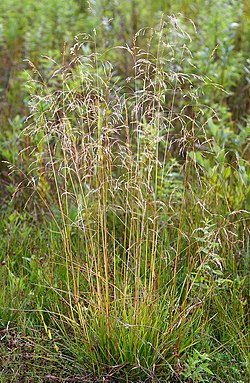| Deschampsia | |
|---|---|
 | |
| Deschampsia cespitosa | |
| Scientific classification | |
| Kingdom: | Plantae |
| Clade: | Tracheophytes |
| Clade: | Angiosperms |
| Clade: | Monocots |
| Clade: | Commelinids |
| Order: | Poales |
| Family: | Poaceae |
| Subfamily: | Pooideae |
| Supertribe: | Poodae |
| Tribe: | Poeae |
| Subtribe: | Aristaveninae F.Albers & Butzin |
| Genus: | Deschampsia P.Beauv. [1] |
| Type species | |
| Deschampsia cespitosa | |
| Synonyms [4] | |
| |
Deschampsia is a genus of plants in the grass family Poaceae, [4] commonly known as hair grass [5] or tussock grass. The genus is widespread across many countries. [6] [7]
Contents
The genus is named for French physician and naturalist Louis Auguste Deschamps (1765–1842). [6] [8]
Deschampsia species are used as food plants by the larvae of some species of Lepidoptera, including antler moth, the clay, clouded-bordered brindle, common wainscot, dark arches, dusky brocade, shoulder-striped wainscot, smoky wainscot and wall.
Deschampsia sometimes grow in boggy acidic formations, an example of which is the Portlethen Moss, Scotland. Deschampsia antarctica is the world's most southern monocot, [9] [10] and one of only two flowering plants of Antarctica. [11] [12]
Some species, such as D. cespitosa, are grown as ornamental garden plants.